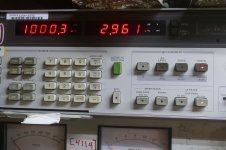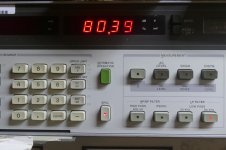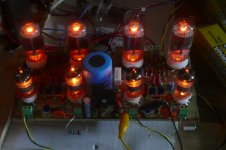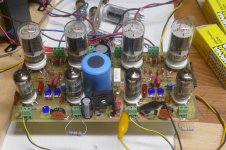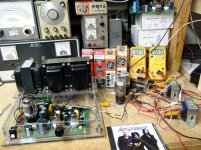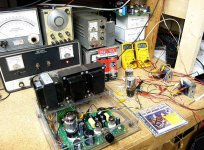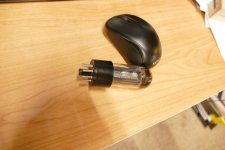I'm thinking that a little 6GF5 Sweep could handle the +grid drive for a Beam Triode in cathode follower mode, with it's plate run up to the Beam Triode plate for current summing. (keeping B+ at 750V or less )
For the curve tracer test I'm just using a 1000V IXYS Mosfet driver/follower similarly.
For a P-P Amplifier with inductive loads, that's a bit less well behaved environment. So 6GF5 will get auditioned there. They were built for Flyback V swings besides.
For the curve tracer test I'm just using a 1000V IXYS Mosfet driver/follower similarly.
For a P-P Amplifier with inductive loads, that's a bit less well behaved environment. So 6GF5 will get auditioned there. They were built for Flyback V swings besides.
Last edited:
Have you ever traced a 6GF5. I have found documentation stating that a 6GF5 is a 6BQ6GT in a Compactron bottle and documentation showing that it is a 6DQ6 in a Compactron bottle. There are no published curves for the 6GF5 that I know of.
Last time I traced a 6GF5 it looked similar to a 12GE5, which would be a close relative of 6DQ6B. The 6GF5 specs are somewhat scattered as to lineage, not quite fitting either 6DQ6 or 6BQ6. That 260,000 Rp spec is obviously a typo. I have the JEDEC datasheet for it, but it doesn't give any more info than the GE datasheet. 6GE5 and 6GF5 were released by GE within a Month of each other in October 1961. I'll get some new curves for the tubes to compare soon. I'm having a problem with the Offset Adjust on the tracer at the moment, so it may take a few days to get it sorted out.
There is no hurry on the 6GF5. It is a curiosity more than anything else as I have over a hundred of them. Your mention of the tube made me wonder if you had a curve set. I have always believed that it is a 6DQ6B with its plate wings clipped off so you can't beat it too hard in the dissipation department. Even with those limitations they will play happily in a 50 WPC HiFi amp that originally ran 17DQ6's.
I have two documents from GE that state this too. I also have a more comprehensive Compactron list that is compiled from GE, RCA and Sylvania data books, that states that it is a 6BQ6GTB. Back in my youth most of my sweep tube experiments involved the 6BQ6 family and the 6DQ6A or B because they were commonly available in discarded TV sets. At the time (I was about 12 years old) I could not understand why the little tubes (6BQ6GT) would crank out lots of power in my DIY guitar amps, but the big tubes (6DQ6) just glowed red distorted and made the transformers get hot. Of course, I didn't understand things like bias, load lines, or impedance matching at the time. The 6BQ6 and 6DQ6 have the same pinout which is compatible with all the popular audio output tubes if you simply solder a plate wire to pin 3 of the socket. A 6BQ6GT will actually work in a Fender Champ for a while until the power transformer starts smoking.
I have two documents from GE that state this too. I also have a more comprehensive Compactron list that is compiled from GE, RCA and Sylvania data books, that states that it is a 6BQ6GTB. Back in my youth most of my sweep tube experiments involved the 6BQ6 family and the 6DQ6A or B because they were commonly available in discarded TV sets. At the time (I was about 12 years old) I could not understand why the little tubes (6BQ6GT) would crank out lots of power in my DIY guitar amps, but the big tubes (6DQ6) just glowed red distorted and made the transformers get hot. Of course, I didn't understand things like bias, load lines, or impedance matching at the time. The 6BQ6 and 6DQ6 have the same pinout which is compatible with all the popular audio output tubes if you simply solder a plate wire to pin 3 of the socket. A 6BQ6GT will actually work in a Fender Champ for a while until the power transformer starts smoking.
Attachments
I've been fighting with the curve tracer here trying to get some curves for these tubes (12GE5, 6GF5, 6BQ6GA). I will eventually get some pics. The tracer seems to have developed a new problem where something smells hot and then after 5 minutes a relay clicks inside and shuts off the display. But I have managed to do some comparisons by letting it cool down repeatedly. First, the GE 6BQ6GA looks like it has the same guts as the GE 12GE5 and it measures near identically. I have an Amperex 12BQ6GA which has a slightly smaller, and squarer plate, and it requires more Vg2 (97V) to match up with 12GE5 and GE 6BQ6GA at 80V. But similar gm. The GE 6GF5 measures near identically with the 12GE5 except it requires 87V on g2 versus 80V on g2 for the 12GE5. Identical gm and offset then. I tried a few 6GF5 and 12GE5 tubes and got similar results (6GF5 requiring around 87V on g2 to match up with the 12GE5 at 80V.
So looks to me that the newer GE 6BQ6GA just has 6GE5 guts. The Amperex is probably the older style 12BQ6. I'll try to find some more BQ6 tubes if I can, but this was not a tube type I ever stocked up on. I have some 6CU6 tubes in the junk bin.
Looks like 6GF5 is VERY similar to 6GE5 but may have a slightly less sensitive g2, this might just be coincidence with so few tube samples so far. I do have a stock of 6GF5 and 12GE5, so I can run through some more tubes.
The 6GF5 and 6BQ6GA tubes both use 1.2 Amps at 6.3 V HTR, similar to a 6GE5. But I do notice that the 6BQ6GA and 6GF5 do have just a slightly narrower cathode than the 12GE5. This may account for the 110 mA DC cathode rating of the (old) 6BQ6 and 160mA DC cathode rating of the 6GF5 (slightly less than the 175 mA rating of the 12GE5.
The 9 Watt rating of the 6GF5 (versus 17.5 Watt 12GE5) does seem to line up with the bottle sizes rather than the plate sizes. But there is the 7754/7695 tubes with a near same size bottle (as 6GF5) and slightly smaller plate, and are rated at 16 Watts. The 12GE5 is rated for 220deg bottle, while the 6GF5 is rated for 200deg bottle. No temp. rating given for 7754/7695. I've noticed before that 7754/7695 has similar curves to 12GE5 (but don't recall off hand at what Vg2)
7754 also uses 1.2 Amps HTR at 6.3V and has a 160 mA DC cathode rating, just like the 6GF5. I do have one 7754, maybe I should compare that too for curves.
Along these in-consistent Watt lines, there is the 21HB5/A that has a plate size just like the 24 Watt 6HJ5 and 28 Watt 6LG6A, but is rated only 18 Watt, and rated 220 deg. bottle, while 6HJ5 is rated 240 deg. and 6LG6 is rated 225 deg bottle. One wonders if marketing has some say on specs or longevity. I did notice that IBM used the 21HB5A in their computer monitors, maybe reliability was paramount there. And Tektronix used the 6GF5 in one of their old tube scope power supplies. May be a high reliability rating.
So looks to me that the newer GE 6BQ6GA just has 6GE5 guts. The Amperex is probably the older style 12BQ6. I'll try to find some more BQ6 tubes if I can, but this was not a tube type I ever stocked up on. I have some 6CU6 tubes in the junk bin.
Looks like 6GF5 is VERY similar to 6GE5 but may have a slightly less sensitive g2, this might just be coincidence with so few tube samples so far. I do have a stock of 6GF5 and 12GE5, so I can run through some more tubes.
The 6GF5 and 6BQ6GA tubes both use 1.2 Amps at 6.3 V HTR, similar to a 6GE5. But I do notice that the 6BQ6GA and 6GF5 do have just a slightly narrower cathode than the 12GE5. This may account for the 110 mA DC cathode rating of the (old) 6BQ6 and 160mA DC cathode rating of the 6GF5 (slightly less than the 175 mA rating of the 12GE5.
The 9 Watt rating of the 6GF5 (versus 17.5 Watt 12GE5) does seem to line up with the bottle sizes rather than the plate sizes. But there is the 7754/7695 tubes with a near same size bottle (as 6GF5) and slightly smaller plate, and are rated at 16 Watts. The 12GE5 is rated for 220deg bottle, while the 6GF5 is rated for 200deg bottle. No temp. rating given for 7754/7695. I've noticed before that 7754/7695 has similar curves to 12GE5 (but don't recall off hand at what Vg2)
7754 also uses 1.2 Amps HTR at 6.3V and has a 160 mA DC cathode rating, just like the 6GF5. I do have one 7754, maybe I should compare that too for curves.
Along these in-consistent Watt lines, there is the 21HB5/A that has a plate size just like the 24 Watt 6HJ5 and 28 Watt 6LG6A, but is rated only 18 Watt, and rated 220 deg. bottle, while 6HJ5 is rated 240 deg. and 6LG6 is rated 225 deg bottle. One wonders if marketing has some say on specs or longevity. I did notice that IBM used the 21HB5A in their computer monitors, maybe reliability was paramount there. And Tektronix used the 6GF5 in one of their old tube scope power supplies. May be a high reliability rating.
Last edited:
Tek 504 scopes from the 60's used a 6DQ6 in a vacuum tube SMPS. We had lots of those scopes in the factory when I was a Mr. Fixit. The scopes were left on 24/7 until they needed fixing. About the only issues were dirty switches and the 6DQ6 which lasted from 1 to 2 years. Maybe the 6GF5 version was an attempt at size reduction. I never saw one of those.And Tektronix used the 6GF5 in one of their old tube scope power supplies. May be a high reliability rating.
We know that the 6BG6G was one of the first TV sweep tubes. It is a 6L6G with a different pinout and a plate cap on top to withstand the HV. At the same time, they also made a tiny sweep tube for tiny TV's by clipping the wings on a 6L6 and stuffing them into a skinny octal bottle about the same size as a 6V6GT. This rarity is the 6BD5GT. Back then most of the tube makers would stuff nearly anything into a glass bottle if a contract for a profitable number of units was involved. About 20 years ago there was a rumor of some 6B4GA's (a DHT triode) with 6AV5 (a TV sweep pentode) guts inside. They were quite rare, but I did find one. They were built to fulfil a government contract for 6B4's which were no longer profitable to manufacture. My tube turned out to be bad, but its discovery led to a lot of triode wired 6AV5's in DHT amps experiments. They did work rather well too.
Here, I simply took my 300B TSE board and wired 6AV5's into it using clip leads. I used cheap OPT's at first as to not risk the Electra Print's in the amp. Tried some 6FW5's too.
My guess is that GE themselves wanted some smallish tubes for their constantly shrinking "PortaColor" TV sets. This reached the limit in small CRT tube TV's at about 12 inches with the 'HE7 and 'HK7 damper / output tube Compactrons. Those little TV's got HOT. Hot enough to warp and discolor the beige plastic. RCA also made 6GF5's, but they are slightly taller and don't take as much abuse as the GE's. I think I have three different size 6GF5 tubes in my collection. The smallest are Zenith branded GE's.
This little board makes 80 WPC at 3% THD without melting.
Attachments
While the curve tracer is behaving itself this morning I got some pics of GE 6GF5 tube curves and a 12GE5.
These are all with 150V on g2, -2V steps on g1 going down from 0V, 50 mA/div Vertical, and 50V/div Horizontal
pic 1 is a GE 6GF5 (this one is exceeding the 12GE5 emission a little at 150Vg2, but has higher knee voltages)
pic 2 is the GE 6GF5 I was looking at last night (surprisingly it now matches the 12GE5 emission at 150Vg2, was slightly lower than the 12GE5 at 80Vg2)
pic 3 is the 12GE5 I was looking at last night
The 6GF5 looks darn close to 12GE5, just the usual tube to tube variation I think. One thing I noticed on these is the 12GE5 has a small cooler fin on the top grid1 supports. I don't see any on the 6GF5s. This is not always consistent across large tube numbers or manu. types. Would have to do some more checking.
Oh, I looked at the cathode width on these tubes and now I don't see any difference. The 6GF5 cathodes are crimped a little differently than the 12GE5s at the mica supports, which may have contributed to some apparent difference before. If there is any difference, it will require busting some tubes to get a caliper in there.
I'll get some 12/6BQ6 curves later. I found a few more in my junkbox.
And I'll trace a Sylvania 6GF5 too.



These are all with 150V on g2, -2V steps on g1 going down from 0V, 50 mA/div Vertical, and 50V/div Horizontal
pic 1 is a GE 6GF5 (this one is exceeding the 12GE5 emission a little at 150Vg2, but has higher knee voltages)
pic 2 is the GE 6GF5 I was looking at last night (surprisingly it now matches the 12GE5 emission at 150Vg2, was slightly lower than the 12GE5 at 80Vg2)
pic 3 is the 12GE5 I was looking at last night
The 6GF5 looks darn close to 12GE5, just the usual tube to tube variation I think. One thing I noticed on these is the 12GE5 has a small cooler fin on the top grid1 supports. I don't see any on the 6GF5s. This is not always consistent across large tube numbers or manu. types. Would have to do some more checking.
Oh, I looked at the cathode width on these tubes and now I don't see any difference. The 6GF5 cathodes are crimped a little differently than the 12GE5s at the mica supports, which may have contributed to some apparent difference before. If there is any difference, it will require busting some tubes to get a caliper in there.
I'll get some 12/6BQ6 curves later. I found a few more in my junkbox.
And I'll trace a Sylvania 6GF5 too.
Last edited:
Here is my Motly crew of 12/6BQ6 tubes curves.
All at 150V on g2, 2V steps on g1 (down from 0V), 50V/div Horiz., and 50 mA/div Vert. Like before.
1) Amperex 12BQ6GA this tube has a smaller plate with square corners and small cooler fin on g1
2) Raytheon 12BQ6GA bigger, black plate, cooler fins on g1 and g2
3) Raytheon 6BQ6GA Japan small cooler fin on g1, big square plate hardly fits in the bottle, someone wrote UL=60 on lower mica!
4) GE 6BQ6GA small cooler fin on g1, plate looks just like GE 12GE5
5) Sylvania 6BQ6/6CU6 square corner gray plate similar to Raytheon
Other than the smallish plate Amperex, these curves all look similar to the 6GF5 and 12GE5





All at 150V on g2, 2V steps on g1 (down from 0V), 50V/div Horiz., and 50 mA/div Vert. Like before.
1) Amperex 12BQ6GA this tube has a smaller plate with square corners and small cooler fin on g1
2) Raytheon 12BQ6GA bigger, black plate, cooler fins on g1 and g2
3) Raytheon 6BQ6GA Japan small cooler fin on g1, big square plate hardly fits in the bottle, someone wrote UL=60 on lower mica!
4) GE 6BQ6GA small cooler fin on g1, plate looks just like GE 12GE5
5) Sylvania 6BQ6/6CU6 square corner gray plate similar to Raytheon
Other than the smallish plate Amperex, these curves all look similar to the 6GF5 and 12GE5
Last edited:
Here are some more 12GE5 tube curves.
Same settings: 150V on g2, -2V steps on g1 going down from 0V, 50 mA/div Vertical, and 50V/div Horizontal
1) another GE 12GE5
2) Sylvania square plate
3) Sylvania GE style plate
I looked at some RCA, Raytheon, Dumont, ITT, and PHILCO 12GE5s and they all had plates just like the GE ones, probably made in the same factory. So I didn't bother tracing them.
Ohh, I noticed on some of the curve sets I didn't get the curves exactly centered on the left axis, in case someone is taking data. 12/6GE5 do have a good GE datasheet at least.



Same settings: 150V on g2, -2V steps on g1 going down from 0V, 50 mA/div Vertical, and 50V/div Horizontal
1) another GE 12GE5
2) Sylvania square plate
3) Sylvania GE style plate
I looked at some RCA, Raytheon, Dumont, ITT, and PHILCO 12GE5s and they all had plates just like the GE ones, probably made in the same factory. So I didn't bother tracing them.
Ohh, I noticed on some of the curve sets I didn't get the curves exactly centered on the left axis, in case someone is taking data. 12/6GE5 do have a good GE datasheet at least.
The 6DQ6B and 12/6GE5 have essentially the same datasheets except for base and plate cap. I think I do have 1 6DQ6B around here somewhere. If I come across it I'll curve trace it too.
-----------------------------------------------------------------------------------------------------------------
Finally, while I have things set up, another interesting tube that lacks curves on it's datasheet is the 22/17/6KV6A. It's described as a HV pulse regulator tube (hey, a little closer to the thread subject at least), but it's just another Sweep tube in reality. The original 6KV6 datasheet was identical to the 6KM6 Sweep tube except not having the cap. The later 6KV6A etc versions were up-rated and characterized specifically for pulse regulator service. Bigger grid 1 cooler fin, higher Watts (28). However the grid 2 diss is reduced (from 3.5W to 2 W ) (the plate stays at HV for pulse regulator service, so the screen doesn't get torched).
The 6JE6 datasheet says that plate diss. rating can be increased 4W for every 1W reduction of screen watts. So if we increase the screen Watts back up to 3.5W for Sweep use, the plate Watts would go down to 22 Watts from 28W. Just for comparing apples to apples on Sweep tube ratings.
I had to reduce the screen V down to 120V (from 150V above) to get the 17KV6A curves to fit on the same 50 mA/div scale. (this tube can do 275 mA DC versus the 175 mA DC for the 12GE5) (and 950 mA peak versus 550 mA peak for the 12GE5) It's a bigger tube.
By the way, the 21HB5A tube (once on the $1 list) has the same size plate and no cap as well (but just 18 Watt diss. rated, I'll bet it can do a -little- more ), and a 12 pin Compactron base. And it even has very similar curves to the 17KV6A on the tracer. (there is a good GE datasheet for the 21HB5A )
The one issue with the 17KV6A tube is the RCA Novar base, for which sockets are scarce. The Chinese Magnoval sockets often claim to fit the Novar base, but usually are loose. Some can be tediously tightened pin by pin, or you can pay more for a US socket than the tube. Kodabmx has a PC board/pin set.
https://www.diyaudio.com/community/...-usa-large-9-pin-tubes-with-1-mm-pins.378427/
17KV6A curves: 120Vg2, 2V grid 1 steps, down from 0V, 50 mA/div Vertical, 50V/div Horizontal


-----------------------------------------------------------------------------------------------------------------
Finally, while I have things set up, another interesting tube that lacks curves on it's datasheet is the 22/17/6KV6A. It's described as a HV pulse regulator tube (hey, a little closer to the thread subject at least), but it's just another Sweep tube in reality. The original 6KV6 datasheet was identical to the 6KM6 Sweep tube except not having the cap. The later 6KV6A etc versions were up-rated and characterized specifically for pulse regulator service. Bigger grid 1 cooler fin, higher Watts (28). However the grid 2 diss is reduced (from 3.5W to 2 W ) (the plate stays at HV for pulse regulator service, so the screen doesn't get torched).
The 6JE6 datasheet says that plate diss. rating can be increased 4W for every 1W reduction of screen watts. So if we increase the screen Watts back up to 3.5W for Sweep use, the plate Watts would go down to 22 Watts from 28W. Just for comparing apples to apples on Sweep tube ratings.
I had to reduce the screen V down to 120V (from 150V above) to get the 17KV6A curves to fit on the same 50 mA/div scale. (this tube can do 275 mA DC versus the 175 mA DC for the 12GE5) (and 950 mA peak versus 550 mA peak for the 12GE5) It's a bigger tube.
By the way, the 21HB5A tube (once on the $1 list) has the same size plate and no cap as well (but just 18 Watt diss. rated, I'll bet it can do a -little- more ), and a 12 pin Compactron base. And it even has very similar curves to the 17KV6A on the tracer. (there is a good GE datasheet for the 21HB5A )
The one issue with the 17KV6A tube is the RCA Novar base, for which sockets are scarce. The Chinese Magnoval sockets often claim to fit the Novar base, but usually are loose. Some can be tediously tightened pin by pin, or you can pay more for a US socket than the tube. Kodabmx has a PC board/pin set.
https://www.diyaudio.com/community/...-usa-large-9-pin-tubes-with-1-mm-pins.378427/
17KV6A curves: 120Vg2, 2V grid 1 steps, down from 0V, 50 mA/div Vertical, 50V/div Horizontal
Last edited:
Getting back to the Beam Triodes, I rigged up an IXYS IXTU01N100 Mosfet (1000V) to drive the grid1 of the beam triodes as a follower, with the grid current returned to the plate via the drain connection. This looks to have improved the triode curves for a flat plate 6JH5 some. Lower Volt knees. But I see a non-linearity (shrunk spacing) in the plate curve spacing now, around the - to + grid transition. This may just be due to my using a wimpy 100K pull-down resistor to cathode for the Mosfet Source (and grid 1) point.
I tried a 6JK5 boxlet/cavity plate tube with the Mosfet too, but the results are not so good , 4th pic below.
The curve tracer is going up to 750V here for these curves, but for a real Amp. more than 2x B+ rating would be needed for the Mosfet driver (with it's Drain connected to the plate for grid current combining). So a small Sweep tube like the 6GF5 (curves above) would be a good fit. I'll get some curves for that setup soon, but I would expect that to be very similar to the Mosfet case.
The Mosfet driver did not even get slightly warm, since it carries most current when the plate V is low.
Since the grid current combining benefit is no big deal, it may be more practical to just use a low voltage Mosfet with it's drain connected to like +15V. A resistor in the drain circuit to limit grid current. (ie., Power Drive)
pics below: same scale as before for the beam triodes: 20 mA/div Vertical, 100V/div Horizontal, more like +0.6V grid steps here (to fit full screen) except +0.5V steps for the 3rd pic (old pic)
1) 6JH5 (flat plate) normal +grid drive (like the previous Beam Triode curves using +grid drive)
2) 6JH5 (flat plate) Mosfet enhanced +grid drive (grid current added to plate current) notice the knees are now closer to the left axis
3) 6JK5 (boxlet/cavity plate) normal +grid drive (previous 6JK5 pic again)
4) 6JK5 (boxlet/cavity plate) Mosfet enhanced +grid drive (grid current added to plate current)
Disappointing that the boxlet plate type is still performing poorly with the Mosfet fix, since these are a far more common beam triode tube.
A small note of hope:
I found some RCA flat plate versions of 6HS5 and 6HV5 on EBAY, about a half dozen of each, and I think they were all short plate type. Only RCAs were like this, and not all the RCAs were this type. So you have to check the EBAY pics carefully.
-----------------------------------------------------------------------------------
And a small note on the 6GF5 mini Sweep tube, I Googled 6GF5 and TEK Oscilloscope and found that 6GF5 was used to power the HV CRT xfmr for the TEK 549 and TEK 556 scopes.




I tried a 6JK5 boxlet/cavity plate tube with the Mosfet too, but the results are not so good , 4th pic below.
The curve tracer is going up to 750V here for these curves, but for a real Amp. more than 2x B+ rating would be needed for the Mosfet driver (with it's Drain connected to the plate for grid current combining). So a small Sweep tube like the 6GF5 (curves above) would be a good fit. I'll get some curves for that setup soon, but I would expect that to be very similar to the Mosfet case.
The Mosfet driver did not even get slightly warm, since it carries most current when the plate V is low.
Since the grid current combining benefit is no big deal, it may be more practical to just use a low voltage Mosfet with it's drain connected to like +15V. A resistor in the drain circuit to limit grid current. (ie., Power Drive)
pics below: same scale as before for the beam triodes: 20 mA/div Vertical, 100V/div Horizontal, more like +0.6V grid steps here (to fit full screen) except +0.5V steps for the 3rd pic (old pic)
1) 6JH5 (flat plate) normal +grid drive (like the previous Beam Triode curves using +grid drive)
2) 6JH5 (flat plate) Mosfet enhanced +grid drive (grid current added to plate current) notice the knees are now closer to the left axis
3) 6JK5 (boxlet/cavity plate) normal +grid drive (previous 6JK5 pic again)
4) 6JK5 (boxlet/cavity plate) Mosfet enhanced +grid drive (grid current added to plate current)
Disappointing that the boxlet plate type is still performing poorly with the Mosfet fix, since these are a far more common beam triode tube.
A small note of hope:
I found some RCA flat plate versions of 6HS5 and 6HV5 on EBAY, about a half dozen of each, and I think they were all short plate type. Only RCAs were like this, and not all the RCAs were this type. So you have to check the EBAY pics carefully.
-----------------------------------------------------------------------------------
And a small note on the 6GF5 mini Sweep tube, I Googled 6GF5 and TEK Oscilloscope and found that 6GF5 was used to power the HV CRT xfmr for the TEK 549 and TEK 556 scopes.
Last edited:
Yep, I changed the Source/grid pull-down resistor to 1K Ohms and the curve spacing anomaly disappeared. Pull-down to -2.5V from cathode actually.
New 6JH5 flat plate with HV Mosfet assist pic #1 below. Nice even curves now. Pic #2 is the normal +grid drive only again for comparison.
Still probably not worth the extra effort for the HV driver to combine grid current with plate current for the modestlly lower knee voltages. (looks like maybe 40V lower knee at 180 mA) But it's an option, especially if one is going to use a lower plate voltage than +750V. The 6GF5 driver should be able to do it easily. Otherwise a LV Mosfet Power Drive will do. (one less tube)
I might use the 6GF5 assist to get by with a 600V B+ supply (highest bench supply currently available here, other than a Variac/Hammond 378CX LC rig)


New 6JH5 flat plate with HV Mosfet assist pic #1 below. Nice even curves now. Pic #2 is the normal +grid drive only again for comparison.
Still probably not worth the extra effort for the HV driver to combine grid current with plate current for the modestlly lower knee voltages. (looks like maybe 40V lower knee at 180 mA) But it's an option, especially if one is going to use a lower plate voltage than +750V. The 6GF5 driver should be able to do it easily. Otherwise a LV Mosfet Power Drive will do. (one less tube)
I might use the 6GF5 assist to get by with a 600V B+ supply (highest bench supply currently available here, other than a Variac/Hammond 378CX LC rig)
Last edited:
Question to you tube-knowers: are there any beam triode tubes á la 6HS5, >25W Pa and 5kV Va max, with heater voltages of say 12V, 15V, 26V, 27V, etc. that you know of?
Jan
Jan
If you can find one, a smallish SiC mosfet may be appropriate for the drive, as you can easily source them with the required higher drain voltage rating. I just checked Digi-Key, and a 1700V rating with fairly manageable gate capacitance is quite possible, and relatively inexpensive. GeneSiC has a 3300V rated device, but the price is extraordinarily steep - it might also not be stocked.
Jan, I don't know if you can get a beam triode with a higher filament voltage - that implies a cheap TV with series string filaments and a "sudden death" chassis. The beam triodes were probably used in pricier color sets.
Jan, I don't know if you can get a beam triode with a higher filament voltage - that implies a cheap TV with series string filaments and a "sudden death" chassis. The beam triodes were probably used in pricier color sets.
Last edited:
Yeah I tried some IXYZ 4500V FETs and IGBTs but gave it up for tubes ;-), for several reasons.
One issue is the Spirito effect if you'd use these switch-HV FETs in their linear range.
Look at the puny SOA (fig 14) for the G2R1000MT33J.
Jan
One issue is the Spirito effect if you'd use these switch-HV FETs in their linear range.
Look at the puny SOA (fig 14) for the G2R1000MT33J.
Jan
Last edited:
I may be missing something here, but if you don't let the part get too hot, the Spirito effect may not be that much of a problem.
Yes it is a problem. Even at 5mA at 2000V. Blew up a couple at $ 80 a shot.
Then I thought, WTF, I ripped out the FETs, connected the 6HS5's K, G and A to S, G, D, put a couple of separate 6.3V psu's in, and it worked flaelessly.
Didn't have to change even one resistor value!
Jan
Then I thought, WTF, I ripped out the FETs, connected the 6HS5's K, G and A to S, G, D, put a couple of separate 6.3V psu's in, and it worked flaelessly.
Didn't have to change even one resistor value!
Jan
I'll have to get some higher V Mosfets to try then. Doesn't look like diss. heat is a problem for this application.
The GE Handbook doesn't show any -non- 6.3V Htr Beam Triodes 3500/5000V type. But then it doesn't show the 26DQ5 tube either. You would think some TVs needed something other than 6.3V. Could try Ebay, but may be lengthy searching.
I've found an odd-ball Zenith 6JD5 Beam Triode in my junk box. It has a boxlet/cavity plate, but the bulge is only half the width I've seen on others. Likely made for a single Barkhausen fin rather than the two fins usually used. I've looked inside it with a magnifying glass and light and I don't see any fin.
So I curve traced it and it's -near- to a flat plate tube. This gives some hope that some of those boxlet types out there may be like this. Tough to tell from many Ebay pics though. Also confirms to me at least that these boxlet deals are the source of the problems.
1) 6JD5 Zenith half boxlet normal +grid scan
2) 6JD5 Zenith half boxlet Mosfet assisted +grid scan
3) pic of the 6JD5 tube plate
4) 6HZ5 flat plate normal +grid scan for comparison




Then again, 6GF5 was $1. Have to see what's available.Even at 5mA at 2000V. Blew up a couple at $ 80 a shot.
The GE Handbook doesn't show any -non- 6.3V Htr Beam Triodes 3500/5000V type. But then it doesn't show the 26DQ5 tube either. You would think some TVs needed something other than 6.3V. Could try Ebay, but may be lengthy searching.
I've found an odd-ball Zenith 6JD5 Beam Triode in my junk box. It has a boxlet/cavity plate, but the bulge is only half the width I've seen on others. Likely made for a single Barkhausen fin rather than the two fins usually used. I've looked inside it with a magnifying glass and light and I don't see any fin.
So I curve traced it and it's -near- to a flat plate tube. This gives some hope that some of those boxlet types out there may be like this. Tough to tell from many Ebay pics though. Also confirms to me at least that these boxlet deals are the source of the problems.
1) 6JD5 Zenith half boxlet normal +grid scan
2) 6JD5 Zenith half boxlet Mosfet assisted +grid scan
3) pic of the 6JD5 tube plate
4) 6HZ5 flat plate normal +grid scan for comparison
Last edited:
- Home
- Amplifiers
- Tubes / Valves
- Advantage of beam triode over simple triode
